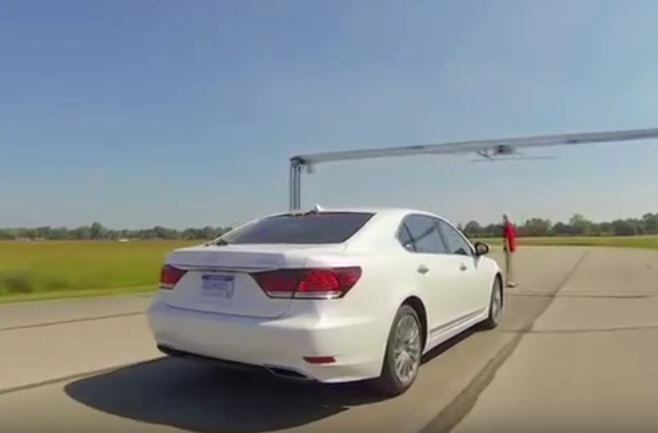Toyota create 'crash test cyclist' to help develop driverless cars
The car maker has built a cycling crash test dummy in order to assess the radar technology on the driverless cars it's developing

The world's biggest car manufacturer has built one of the world's first crash test bicycles, complete with a crash test cyclist.
The new bike is like a jigsaw. It has pieces made of a shatter-resistant material. They break apart in a collision and can be slotted back together quickly, ready for another impact.
>>> Renault CEO says cyclists are the biggest problem for driverless cars
It's been designed by engineers in the US for Toyota's Collaborative Safety Research Center.
They need a bike which withstands multiple impacts so it can be a target for proving that new car radar technology for driverless cars can detect cyclists.
Toyota plans to sell driverless cars by 2020 and they'll need radar on board to avoid hitting cyclists. The same technology could also help drivers of ordinary cars to brake and steer away before any collision.
But realistic tests of the new radar systems are difficult – no sensible cyclist would volunteer to pedal into the path of a moving car.
Get The Leadout Newsletter
The latest race content, interviews, features, reviews and expert buying guides, direct to your inbox!
So Toyota commissioned the crash test bike. It's modelled on a 26 inch mountain bike because that's the most popular adult bicycle sold in the US.
Watch: Hovding Airbag helmet put to the test
The detachable, unbreakable pieces are made from a material that looks exactly the same to radar as a real bicycle.
There's more to the project than the bike alone. A bicycle on its own would be unrealistic so the engineers have also created a crash test cyclist to endure the repeated impacts.
Its legs go round as if pedalling and it has a special covering to mimic the radar signature of human skin.
With a dummy bike and dummy rider ready to take multiple hits for the team, Toyota also had to come up with a way to propel them across the test track.
>>> Zac Goldsmith: ‘I’ll rip up London’s cycle superhighways if they don’t work’
The engineers knew the motor of an electric bike would get damaged in repeated smashes so they designed a robust small four-wheeled motorised platform to carry the crash test bike to the point of collision.
The platform can deliver the bike at a pace many cyclists would envy. "It can be moved at a speed of 20mph with up to 10mph wind in any direction," say the engineers. "It can be collided by vehicles from any direction at up to 38mph vehicle speed and reassembled in less than five minutes."
Of course, the hope is the car radar will detect the bike and rider in time to activate emergency braking before any impact happens.
Pictures of the crash test bicycle and cyclist are not expected to be released until the World Congress of the Society of Automotive Engineers in Detroit in April, but a video of Toyota's crash test pedestrian gives an idea of the tests they will go through.
https://www.youtube.com/watch?v=OK8HJ_zUOfQ
It's hoped the crash test cyclist does not look as if it, too, comes from Tracy Island.
Max Glaskin is an award-winning freelance journalist who tweets about cycling and science as @CyclingScience1 and is the author of Cycling Science (published by Frances Lincoln UK, Chicago University Press USA, and seven other languages)

Thank you for reading 20 articles this month* Join now for unlimited access
Enjoy your first month for just £1 / $1 / €1
*Read 5 free articles per month without a subscription

Join now for unlimited access
Try first month for just £1 / $1 / €1
-
 'It took everything' - Puck Pieterse outclimbs Demi Vollering to win La Flèche Wallonne
'It took everything' - Puck Pieterse outclimbs Demi Vollering to win La Flèche WallonneDutch 22-year-old shows Classics pedigree with first one-day victory
By Tom Davidson
-
 Tadej Pogačar flies to dominant victory at La Flèche Wallonne
Tadej Pogačar flies to dominant victory at La Flèche WallonneSlovenian takes second win at Belgian classic ahead of Kévin Vauquelin and Tom Pidcock
By Tom Thewlis